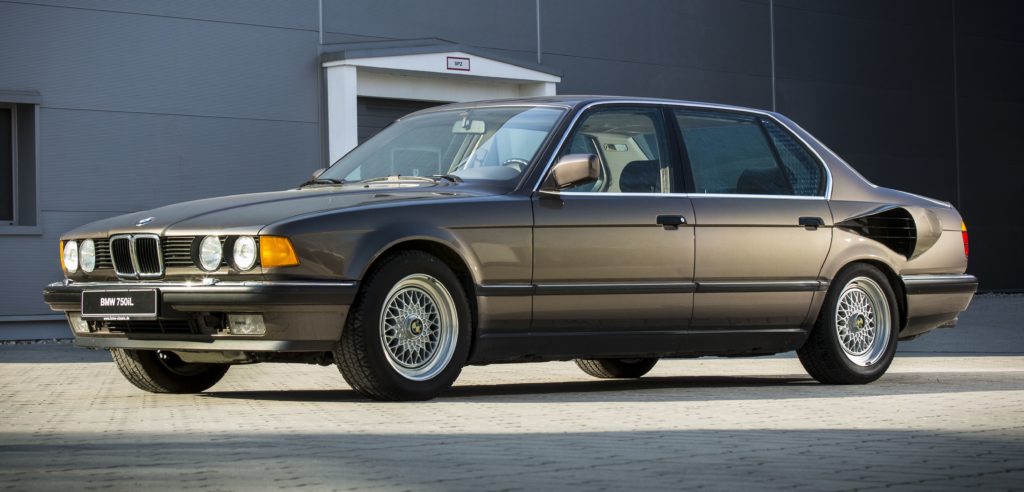I’ve always been skeptical of concept cars. When you think of them, a bold and polarizing visage is what often comes to mind—but how often do those audacious designs become reality? We routinely hear promises of production, but how often do they come to fruition, becoming more than just an intriguing blueprint?
As a brand, BMW has a sort of backwards-way of dealing with concept car skepticism, that is, they build it first and let people ask questions later. Wacky proportions? Make it happen. Funky drivetrain setup? Do it. When you amass such a collective curiosity for the peculiar, mystifying, and limitless world of automotive design, and have an arsenal of zealous engineers at the ready, you have to act on it, and BMW did just that. This enthusiast mindset is why we have seen some crazy one-off Bimmers emerge from Munich over the decades, including the likes of the M Vision Next, and more recently, the X7 pickup truck.
The M70 V12 found in the original 750iL was already a tight fit in the engine bay.
But there was always one one-off that stood out from the rest—a 1987 V16-powered E32 7-series with a rather peculiar name. Nicknamed Goldfisch, the beefed-up 7 was the result of a year-long covert operation, a creative exploit by some of BMW’s best and brightest. It quickly became a pet project for BMW engineers at the time, with lead powertrain engineer Dr. Karlheinz Lange and Adolf Fischer dictating the design and mechanical composition of the luxurious one-off. While the two engineers certainly weren’t fishing for consumer compliments with this build, it wouldn’t have mattered anyway—it was never intended to hit the production line. Lange enlisted the expertise of Fischer, who had designed the M70 V12 for the 750iL, to create a new heart for the Seven—a monstrous V16 engine cast from aluminum that was nearly a foot longer than the stock V12 in the 750iL. Those four extra cylinders also produced a whopping 108 horsepower more than the already quick 300 horsepower V12, a power figure that already crushed the horsepower numbers of M models from the era.
With the radiator moved to the back, the beefy V16 engine could be squeezed between the wheel wells.
In order to fit the 16-cylinder monster under the hood, however, the engine bay would need some rearranging. The path of least resistance meant doing away with the radiator setup in favor of one similar to the 3.0 CSL’s, which replaced the main radiator in the engine bay for two smaller units in the trunk. This decision presented its own set of challenges, however, and the entire rear of the car had to be adapted to accommodate the changes. For heat dissipation purposes, the rear fascia of the trunk was replaced with a grille, and the rear quarter panels were fitted with massive cooling ducts, bearing an uncanny resemblance to gills. Now that the fish (whale?) could breathe, the final step was to determine how it would swim, er, drive. A six-speed manual transmission was plucked from the 8-series parts bin and dropped straight into the chassis, allowing for driver engagement with all sixteen cylinders. The completed prototype achieved a maximum speed of 175 mph and wore a fresh coat of metallic gold paint, earning its Goldfish name.
The dual-radiator setup in the modified rear of the car.
There’s a reason why this fast fish is making the headlines yet again, and it’s simply because its too insane not to. It’s a V16 with three pedals, a gold paint finish, and massive air dams resembling fins—what’s not to love? But enough of the fish puns, I’ll scale back. I have a certain level of admiration for BMW’s willingness to create the unimaginable, and do things just for the sake of curiosity. In all seriousness, the 7 Series Goldfisch is a one-off BMW that has earned the right to take center stage again. It’s a wacky concoction of all of the raw genius of BMW’s engineers, and its an invention that will continue to amaze us for years to come, especially as engines and cylinder counts continue to shrink.—Malia Murphy
[Photos Courtesy BMW Group Classic.]
